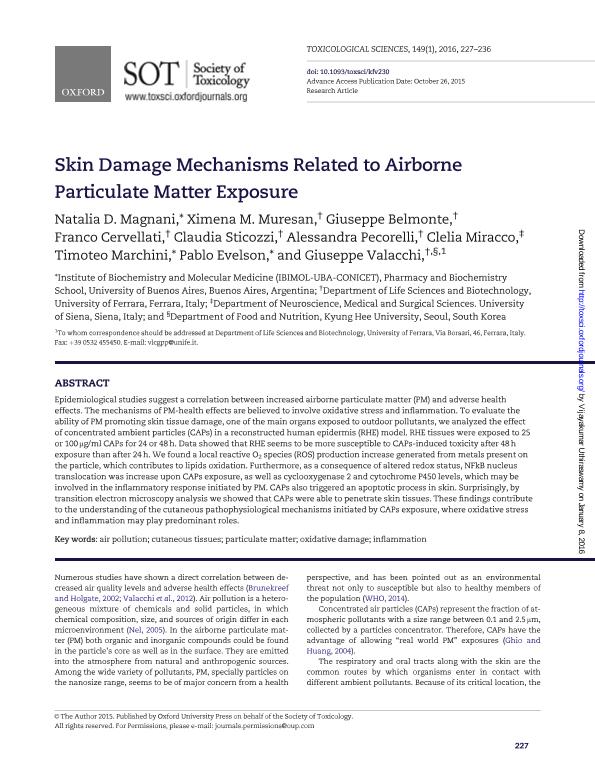Artículo
Skin damage mechanisms related to airborne particulate matter exposure
Magnani, Natalia Daniela ; Muresan, Ximena M.; Belmonte, Giuseppe; Cervellati, Franco; Sticozzi, Claudia; Pecorelli, Alessandra; Miracco, Clelia; Marchini, Timoteo Oscar
; Muresan, Ximena M.; Belmonte, Giuseppe; Cervellati, Franco; Sticozzi, Claudia; Pecorelli, Alessandra; Miracco, Clelia; Marchini, Timoteo Oscar ; Evelson, Pablo Andrés
; Evelson, Pablo Andrés ; Valacchi, Giuseppe
; Valacchi, Giuseppe
 ; Muresan, Ximena M.; Belmonte, Giuseppe; Cervellati, Franco; Sticozzi, Claudia; Pecorelli, Alessandra; Miracco, Clelia; Marchini, Timoteo Oscar
; Muresan, Ximena M.; Belmonte, Giuseppe; Cervellati, Franco; Sticozzi, Claudia; Pecorelli, Alessandra; Miracco, Clelia; Marchini, Timoteo Oscar ; Evelson, Pablo Andrés
; Evelson, Pablo Andrés ; Valacchi, Giuseppe
; Valacchi, Giuseppe
Fecha de publicación:
01/2016
Editorial:
Oxford University Press
Revista:
Toxicological Sciences
ISSN:
1096-6080
Idioma:
Inglés
Tipo de recurso:
Artículo publicado
Clasificación temática:
Resumen
Epidemiological studies suggest a correlation between increased airborne particulate matter (PM) and adverse health effects. The mechanisms of PM-health effects are believed to involve oxidative stress and inflammation. To evaluate the ability of PM promoting skin tissue damage, one of the main organs exposed to outdoor pollutants, we analyzed the effect of concentrated ambient particles (CAPs) in a reconstructed human epidermis (RHE) model. RHE tissues were exposed to 25 or 100 μg/ml CAPs for 24 or 48 h. Data showed that RHE seems to be more susceptible to CAPs-induced toxicity after 48 h exposure than after 24 h. We found a local reactive O2 species (ROS) production increase generated from metals present on the particle, which contributes to lipids oxidation. Furthermore, as a consequence of altered redox status, NFkB nucleus translocation was increase upon CAPs exposure, as well as cyclooxygenase 2 and cytochrome P450 levels, which may be involved in the inflammatory response initiated by PM. CAPs also triggered an apoptotic process in skin. Surprisingly, by transition electron microscopy analysis we showed that CAPs were able to penetrate skin tissues. These findings contribute to the understanding of the cutaneous pathophysiological mechanisms initiated by CAPs exposure, where oxidative stress and inflammation may play predominant roles.
Archivos asociados
Licencia
Identificadores
Colecciones
Articulos(IBIMOL)
Articulos de INSTITUTO DE BIOQUIMICA Y MEDICINA MOLECULAR
Articulos de INSTITUTO DE BIOQUIMICA Y MEDICINA MOLECULAR
Citación
Magnani, Natalia Daniela; Muresan, Ximena M.; Belmonte, Giuseppe; Cervellati, Franco; Sticozzi, Claudia; et al.; Skin damage mechanisms related to airborne particulate matter exposure; Oxford University Press; Toxicological Sciences; 149; 1; 1-2016; 227-236
Compartir
Altmétricas



